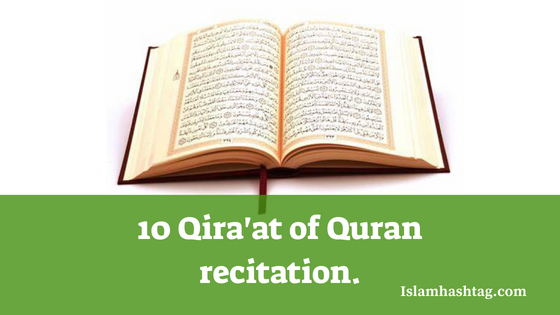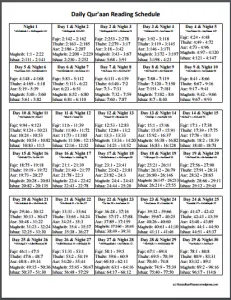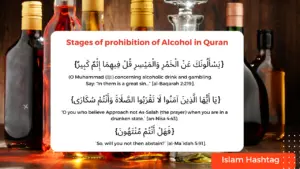What is Qirat in Islam?
10 Qira’at of Quran recitation: Qirat / Qirāʼah, (pl. Qirāʼāt; Arabic: قراءات refers to the various ways of reciting the Holy Quran. Each Qirat has its own certain rules of recitation and variations in words and letters. Qirat also refers to the branch of Islamic studies that deals with these recitation manners.
What are the ten qirats of the Quran/10 Quran reading

Differences between Qiraʼat are slight and include varying rules regarding the prolongation, intonation, and pronunciation of words (for example, in Surat al-Baqara : “Dhalika’l-Kitabu la rayb” or “Dhalika’l-Kitabu la rayba fih,)but also differences in stops (“suddan” or “saddan) ,vowels (a word having a long consonant or not) , consonants (leading to different pronouns and verb forms), and less frequently entire words(“fa-tabayyanu” or “fa-tathabbatu” in Q4.94.)
In this context, we should mentioned that the Prophet (sallalahu alaihe wa sallam) himself said that the Qur’an was revealed in seven dialects (ahruf, sing harf). Harf here means dialect, idiom, or mode of expression. Now, during the khalifate of ‘Uthman, this had given rise to squabbling. For instance, the Syrians followed Ubayy ibn Ka’b, the Kufans followed ‘Abdullah ibn Mas’ud, the people of Hims followed al-Miqdad, and the people of Basra followed Abu Musa. To put an end to these squabbles over which was best, ‘Uthman decided to unite the community behind one text.
Therefore one should always follow a single Qira’at and a single qari whenever they are trying to learn Quran.
Also read : Different type of Tafsir
10 Qira’at of Quran recitation.
There are ten different recognised schools of qiraʼat, each one deriving its name from a noted Quran reciter or “reader” (qāriʾ pl. qāriʾūn or qurr’aʿ). The readings themselves have a chain of transmission (like hadith) going back to the time of Muhammad Sallalahu alaihe wa sallam.
Consequently, the readers/qurr’aʿ who give their name to Qira’at are part of a chain of transmission called a riwaya.
The lines of transmission passed down from a riwaya are called turuq, and those passed down from a turuq are called wujuh
Each Qira’ah has its own Tajwid (rules of recitation)
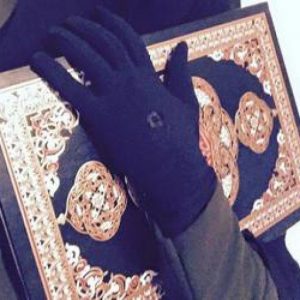
The muṣḥaf Quran that is in “general use” throughout almost all the Muslim world today is a 1924 Egyptian edition based on the Qira’at “reading of Ḥafṣ on the authority of Asim (Ḥafṣ being the Rawi, or “transmitter”, and Asim being the Qari or “reader”)
The seven qira’at readings which are currently notable were selected in the fourth century by Abu Bakr Ibn Mujahid (died 324 AH, 936 CE) from prominent reciters of his time, three from Kufa and one each from Mecca, Medina, and Basra and Damascus.[23] Later, three more recitations were canonized for ten.
The qira’at or the readings, or methods of recitation, are named after the leader of a school of Qur’an reciters. Each qira’a derives its authority from a prominent leader of recitation in the second or third century hijri who in turn trace their riwaya or transmission back through the Companions of the Prophet.(radi allahu anhu)
10 Qir’at
As for the & Mutawatir Qirat recitations, they are:
- Ibn ‘Amr (from Châm) died in 118. (ibn Dhakwân and Hichâm reported from him)
- Ibn Katheer (from Mecca) died in 120. (Al Bazzy and Qunbool reported from him)
- Nafi ‘(from Medina) died in 169. (Qaloon and Warsh reported from him)
- ‘Asim (from Kufa in Iraq) died in 127. (Shu’ba and Hafs reported from him)
- Hamza (from Kufa) died in 156. (Khalaf and Khallad reported from him)
- Abu Amru (from Basra in Iraq) died in 154. (Ad Doury and As Soussy reported from him)
- Al Kassai (from Koufa) died in 189. (Abu Al Hârith and Ad Doury reported from him)
- Khalaf (from Kufa) died in 229. (Idris and Ishaq reported from him)
- Abu Ja’far (from Medina) died in 130. (ibn Wardan and Ibn Jammaz reported from him)
- Ya’qub (from Kufa) died in 205. (Rooais and Rawh reported from him)
Sanad of Warsh Qirat:
“the riwaya of Imam Warsh from Nafi’ al-Madini from Abu Ja’far Yazid ibn al-Qa’qa’ from ‘Abdullah ibn ‘Abbas from Ubayy ibn Ka’b from the Messenger of Allah, may Allah bless him and grant him peace, from Jibril, peace be upon him, from the Creator.”
Sanad of Hafs Qiraat
“the riwaya of Hafs ibn Sulayman ibn al-Mughira al-Asadi al-Kufi of the qira’a of ‘Asim ibn Abi’n-Nujud al-Kufi from Abu ‘Abdu’r-Rahman ‘Abdullah ibn Habib as-Sulami from ‘Uthman ibn ‘Affan and ‘Ali ibn Abi Talib and Zayd ibn Thabit and Ubayy ibn Ka’b from the Prophet, may Allah bless him and grant him peace.” These all go back to the Prophet. from Jibril, peace be upon him, from the Creator.”
List of 10 Qira’at of Quran recitation.
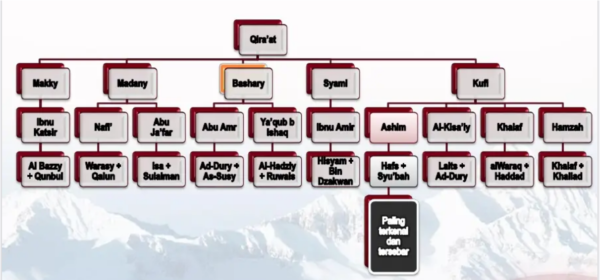
Within the qira’at, there are two categories:
Mutawatir: a transmission which has independent chains of authorities so wide as to rule out the possibility of any error and on which there is consensus.
Mashhur: these are slightly less wide in their transmission, but still so wide as to make error highly unlikely.
There are 7 mutawatir qira’at and 3 mashhur ones.
As for the & Mutawatir Qirat recitations, they are:
- Ibn ‘Amr (from Châm) died in 118. (ibn Dhakwân and Hichâm reported from him)
- Ibn Katheer (from Mecca) died in 120. (Al Bazzy and Qunbool reported from him)
- Nafi ‘(from Medina) died in 169. (Qaloon and Warsh reported from him)
- ‘Asim (from Kufa in Iraq) died in 127. (Shu’ba and Hafs reported from him)
- Hamza (from Kufa) died in 156. (Khalaf and Khallad reported from him)
- Abu Amru (from Basra in Iraq) died in 154. (Ad Doury and As Soussy reported from him)
- Al Kassai (from Koufa) died in 189. (Abu Al Hârith and Ad Doury reported from him)
For the ten recitations, we add the following three mashur Qirat:
- Khalaf (from Kufa) died in 229. (Idris and Ishaq reported from him)
- Abu Ja’far (from Medina) died in 130. (ibn Wardan and Ibn Jammaz reported from him)
- Ya’qub (from Kufa) died in 205. (Rooais and Rawh reported from him)
Today, the two readings must used are the qira’a of ‘Asim in the riwaya of Hafs, and the qira’a of Nafi’ in the riwaya of Warsh. Also in use in Africa is the qira’a of Abu ‘Amir in the riwaya of ad-Duri.
| 1 | Ibn Amr |
| 2 | Ibn Katheer |
| 3 | Nafi |
| 4 | Asim |
| 5 | Hamza |
| 6 | Abu Amru |
| 7 | Al Kassai |
| 8 | Khalaf |
| 9 | Abu Ja’far |
| 10 | Ya’qub |
Concluding note
Aisha Abdurrahman Bewley writes that different qirāʿāt have “different diacritical marks”, and the differences “compliment other recitations and add to the meaning, and are a source of exegesis.”(reference)
Ammar Khatib and Nazir Khan contend that qiraat “constitute a unique feature of the Qur’an that multiplies its eloquence and aesthetic beauty”, and “in certain cases” the differences in qirāʾāt “add nuances in meaning, complementing one another.
Discover more from Islam Hashtag
Subscribe to get the latest posts sent to your email.

